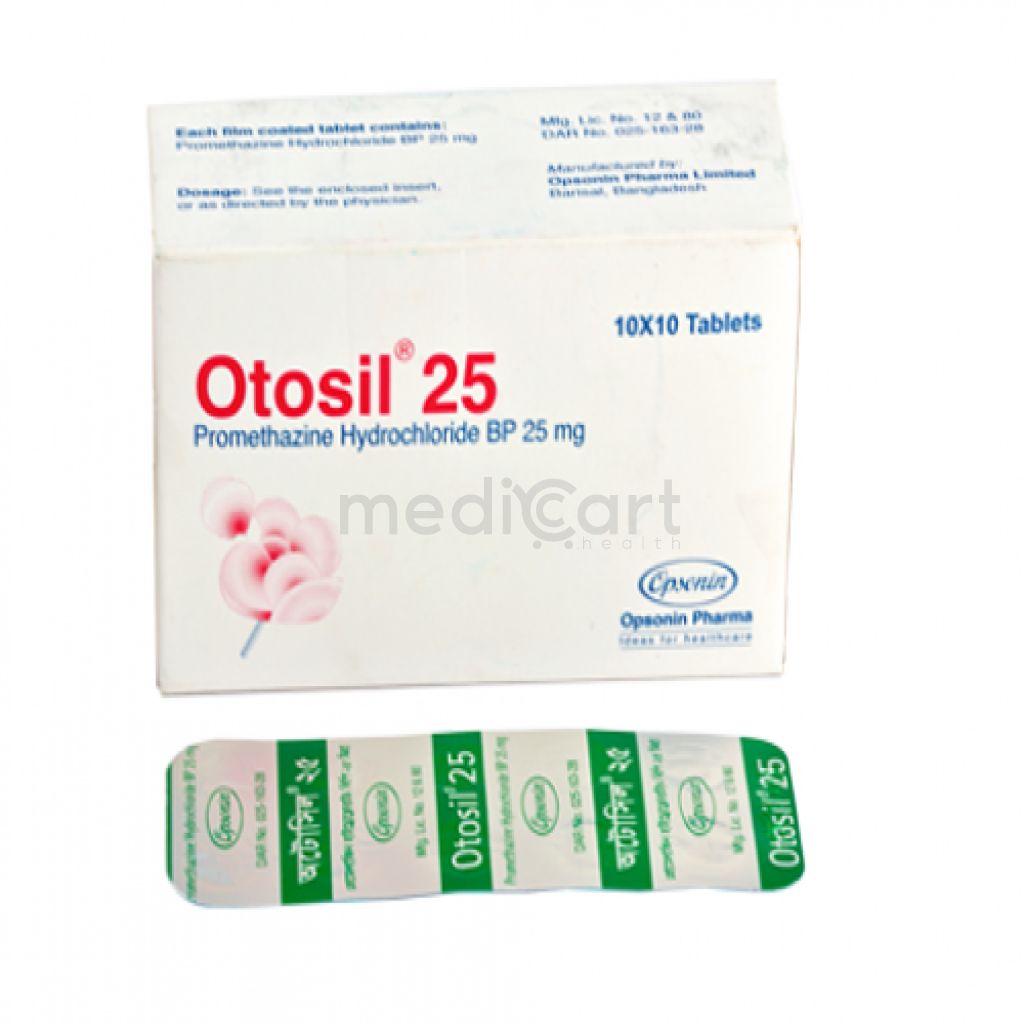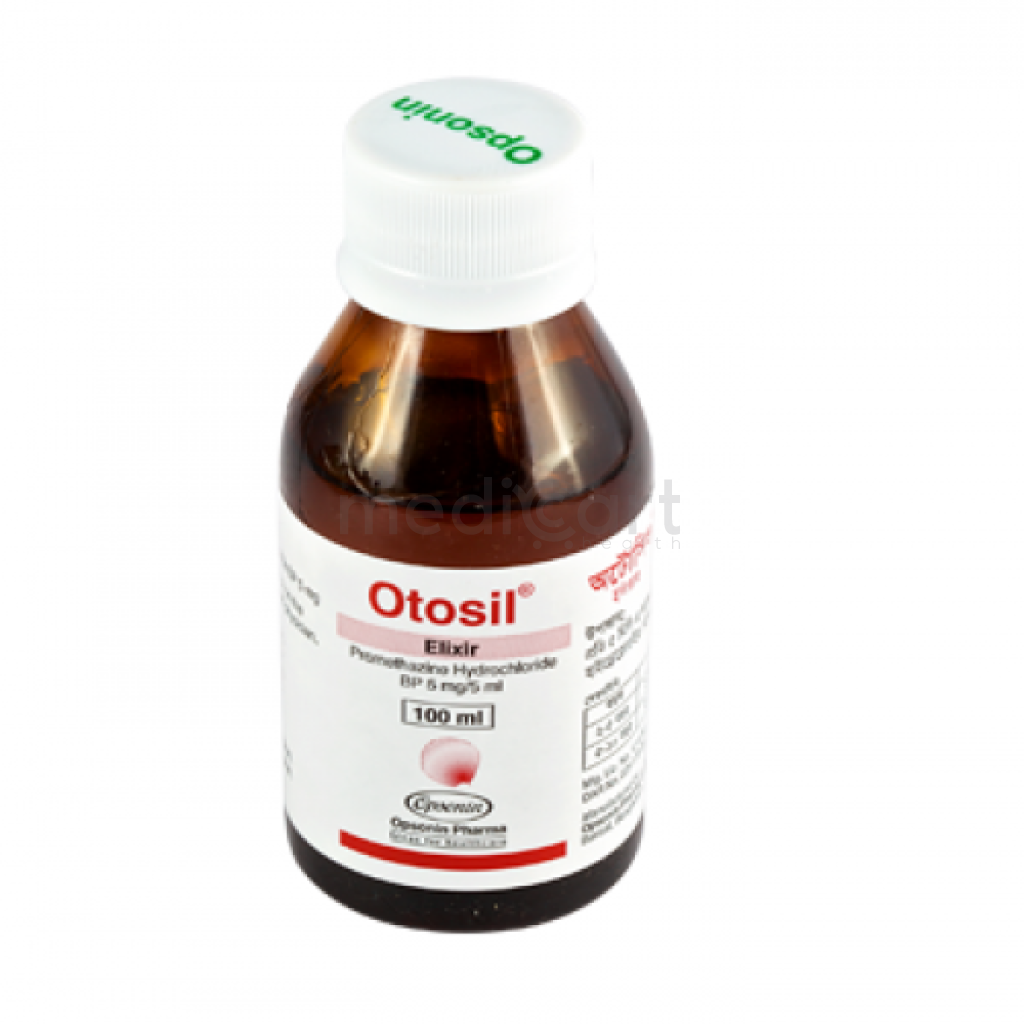

Otosil 25mg
Tablet* Delivery will be done in Dhaka city only.
More Information About - Otosil 25mg
Description
Indication:
Allergic conditions, Nausea and vomiting, Motion sickness, Insomnia
Pharmacology:
Promethazine is a phenothiazine derivative that inhibits the brain's postsynaptic mesolimbic dopaminergic receptors. It has a significant -adrenergic blocking action and inhibits hypothalamus and hypophyseal hormone release. It competes with histamine for the H1-receptor; the antiemetic action may be due to the muscarinic blocking effect. It also lowers the amount of stimulation to the brainstem reticular system.
The gastrointestinal system absorbs promethazine effectively. Clinical effects are seen after 20 minutes of oral ingestion and typically last four to six hours, however they might last up to 12 hours. The liver metabolizes promethazine to a number of chemicals, the most common of which are promethazine sulfoxides and N-demethylpromethazine in the urine.
Dosage (breakdown or, not) :
No specific dosage recommendations.
Adults:
Initial dose one 25 mg tablet at night; may be increased to two or three 25 mg tablets at night if necessary. In allergic conditions more frequently administration, twice or three times daily, may be necessary, starting with one or two 10 mg tablets and increasing as required.
Child:
They may be treated more conveniently by the elixir containing 5 mg/5 ml.
As an antihistamine in allergy:
- Children of 2-5 years: 5-15 mg
- Children of 5-10 years: 10-25 mg
- In the case where two doses in 24 hours are required, the lower dose stated should be given.
As a sedative:
- Children of 2-5 years: 15-20 mg
- Children of 5-10 years: 20-25 mg
- Given as a single night-time dose
Administration:
May be taken with or without food.
Interaction:
Masks ototoxicity of aminoglycoside antibiotics. May enhance the sedative effects of CNS depressants like alcohol, hypnotics, barbiturates and opioids. Potentially Fatal: Ventricular arrhythmias when used with drugs that prolong QT interval. Increased risk of extrapyramydal effects w/ MAOIs.
Contraindication:
Patients in coma or suffering from CNS depression of any cause. Childn <2 yr. SC and intra-arterial admin. Concurrent use w/ or w/in 14 days of MAOI use.
Side Effect:
Neuroleptic Malignant Syndrome (NMS); CV effects (e.g. bradycardia, tachycardia, transient HTN, hypotension; jaundice, blood dyscrasias, extrapyramidal effects; IV inj: Severe tissue injury (e.g. gangrene), pain and burning, paralysis, thrombophlebitis, severe spasm of distal vessels, necrosis. Sedation, Confusion, Disorientation, Blurred vision, Hallucinations, Dystonias, Catatonic states, Euphoria, Excitation, Impotence, Urinary retention Potentially Fatal: Resp depression and apnoea esp in childn.
Pregnancy & Lactation:
Although there is epidemiological evidence for the safety of promethazine in pregnancy and animal studies have indicated no risk, it should not be taken in pregnancy unless the doctor believes it is absolutely necessary. The use of Phenergan in the two weeks preceding birth is not advised due to the possibility of irritability and excitation in the neonate. Promethazine has produced long-term neurological problems in infants when administered in large dosages during late pregnancy. Promethazine should only be taken during pregnancy if the potential benefits to the patient outweigh the potential risks to the fetus. Breastmilk contains promethazine.There is a possibility of neonatal irritability and excitation.
Precautions & Warnings:
- The use of promethazine should be avoided in children and adolescents with signs and symptoms suggestive of Reye’s syndrome.
- Promethazine may thicken or dry lung secretions and impair expectoration. It should therefore be used with caution in patients with asthma, bronchitis or bronchiectasis.
- Use with care in patients with severe coronary artery disease.
- Use with care in patients with narrow angle glaucoma.
- Use with care in patients with epilepsy.
- Use with care in patients with hepatic insufciency.
- Use with care in patients with renal insufciency.
- Caution should be exercised in patients with bladder neck obstruction.
- Caution should be exercised in patients with pyloro-duodenal obstruction.
Storage Conditions:
Keep out of direct sunlight. Do not use after the expiry date. Keep any medications out of children's reach. Only on the prescription of a qualified physician can it be dispensed.
Disclaimer
The information provided herein are for informational purposes only and not intended to be a substitute for professional medical advice, diagnosis, or treatment. Please note that this information should not be treated as a replacement for physical medical consultation or advice. Great effort has been placed to provide accurate and comprehensive data. However, Medicart along with its authors and editors make no representations or warranties and specifically disclaim all liability for any medical information provided on the site. The absence of any information and/or warning to any drug shall not be considered and assumed as an implied assurance of the Company.








